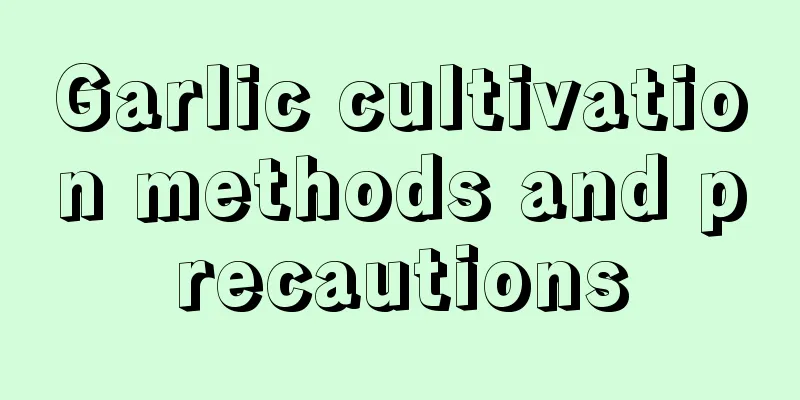Garlic cultivation methods and precautions

1. Breeding methods1. Temperature: 18 to 26 degrees is the most suitable. It has good cold resistance and can withstand temperatures as low as minus five degrees Celsius in winter. Therefore, if you are in an area where the temperature is below this limit in winter, you need to take appropriate measures to protect yourself from the cold. 2. Light: The growth of garlic cannot be separated from the help of light. Under good lighting conditions, it grows well and produces more. Generally speaking, when it grows fastest, it needs to be provided with about ten hours of light a day for it to grow well. If the day length is short, the stems and leaves may become elongated. 3. Watering: Garlic is a plant that likes moisture, and it is very afraid of dryness. When the soil is dry, it needs to be watered in time. Generally speaking, you need to replenish water when it is half dry. 4. Fertilization: Fertilize garlic mainly with base fertilizer. It is usually added when turning the soil in late September. The top dressing required is not too much, usually in early April, use an appropriate amount of urea, etc. 2. Breeding techniques1. Reproduction: The main method used is seed propagation. The first thing is to choose seeds. The size of seeds has a great impact on the success rate of reproduction and subsequent yield. The best time to sow is in late September or early October, when the temperature is around 17 degrees. The row spacing is controlled at about 20 cm, and the plant spacing is between 16 and 18 cm. After sowing, watering is required. 2. Pruning: Garlic also needs to be pruned appropriately during its growth period. However, the number of times does not need to be too many. Pruning is a good auxiliary measure, especially when diseases or insect pests occur. At other times, you can prune at the appropriate time, but don't be too strong. 3. Problem diagnosis and treatment1. Disease: There may be "leaf blight", which is the main disease of garlic and seriously affects the yield. The frequency of occurrence is higher in April. It can be controlled by using Benomyl. There may also be "epidemics", which can be prevented and controlled with ethylene phosphine aluminum manganese zinc, and the water and fertilizer also need to be regulated. 2. Pests: The main type is "garlic maggot". Wood ash can be used to effectively prevent the damage of this pest. In serious cases, chlorpyrifos emulsifiable concentrate can also be used for prevention and control. IV. Other issues1. Toxicity: Garlic plants are non-toxic and edible. 2. Can it be grown at home: Garlic can be grown at home. The operation is easy and you can eat the garlic you grow yourself. Moreover, it won’t take up too much space. |
<<: The cultivation methods and precautions of Duzhanchun
>>: The cultivation methods and precautions of Daxuesu
Recommend
Cutting methods and precautions for Christmas cactus. Which month is best for cutting?
The flowers of Christmas cactus are very beautifu...
When is the best time to transplant Sophora japonica trees? (Sophora japonica tree transplanting time and method)
The best place to transplant a Sophora japonica t...
Can Jade Plants be hydroponically cultivated?
Can Jade Plants be hydroponically cultivated? It ...
Rapeseed flower pictures (introduction to morphological characteristics and maintenance methods)
1. Morphological characteristics 1. Stem: The ste...
What soil is suitable for planting Photinia fraseri
Photinia soil Photinia prefers slightly acidic so...
The correct way to water crabapples and the signs of underwatering
1. Watering method Begonia likes relatively moist...
What flowers are suitable for growing in Daqing? What are the city flowers and trees?
1. Daqing's climate characteristics Daqing ha...
How to cultivate thick roots of jasmine
1. Put it in the basin We can add some substances...
Can Tiger Pilan be hydroponically cultivated?
1. Can it be hydroponically grown? Sansevieria ha...
How to grow osmanthus in the north through the winter?
Winter precautions: In fact, osmanthus has some a...
How to reproduce avocado, how to reproduce avocado
1. Seed propagation 1. Sowing time: Avocado is ge...
What fertilizer is best for crape myrtle?
Crape myrtle fertilization time Generally speakin...
The white orchids at home bloom every day, and we can’t pick them all. Neighbors come to buy them!
White Orchid Nowadays, fewer people grow white or...
Can litchi shells be used as fertilizer?
Lychee shells as fertilizer Lychee shells can be ...
Cultivation method of multi-headed chrysanthemum potted plants
1. Watering The amount of water required by multi...









